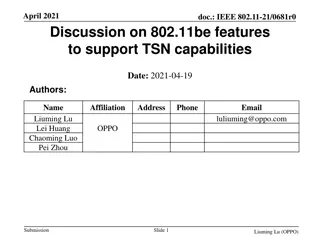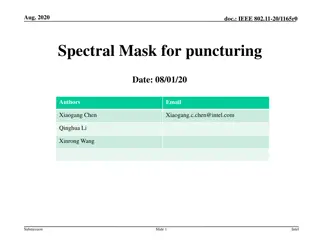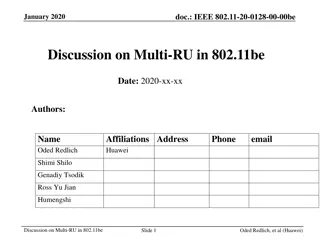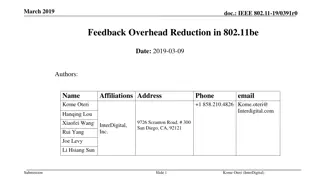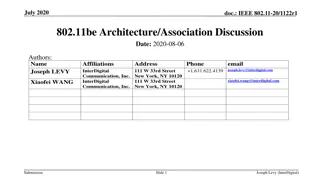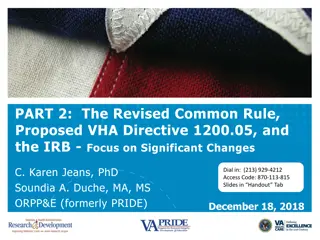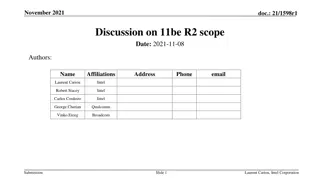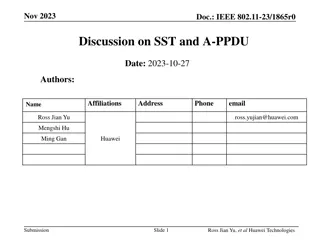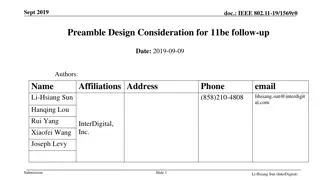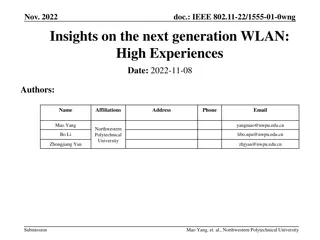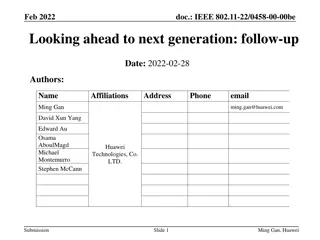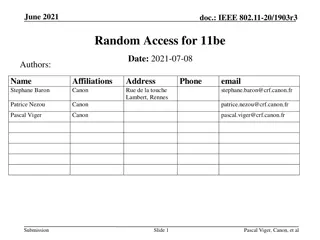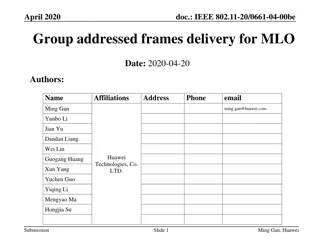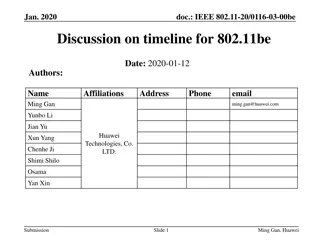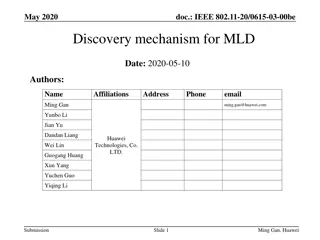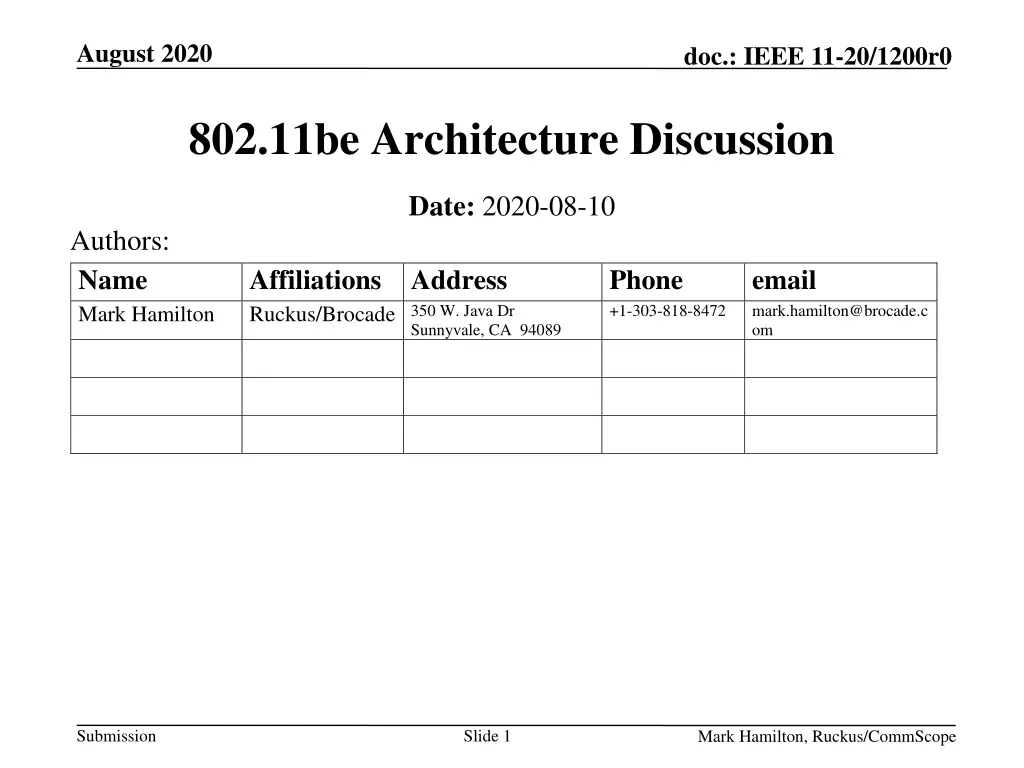
IEEE 11-20/1200r0 Architecture Discussion
Explore the architecture discussion on IEEE 11-20/1200r0 in the August 2020 document by Mark Hamilton from Ruckus/CommScope. The presentation delves into the relationship of TGbe concepts with the existing 802.11 architecture, presenting diagrams and insights on multi-link device architecture and management complexities.
Download Presentation

Please find below an Image/Link to download the presentation.
The content on the website is provided AS IS for your information and personal use only. It may not be sold, licensed, or shared on other websites without obtaining consent from the author. If you encounter any issues during the download, it is possible that the publisher has removed the file from their server.
You are allowed to download the files provided on this website for personal or commercial use, subject to the condition that they are used lawfully. All files are the property of their respective owners.
The content on the website is provided AS IS for your information and personal use only. It may not be sold, licensed, or shared on other websites without obtaining consent from the author.
E N D
Presentation Transcript
August 2020 doc.: IEEE 11-20/1200r0 802.11be Architecture Discussion Date: 2020-08-10 Authors: Name Mark Hamilton Affiliations Address Ruckus/Brocade 350 W. Java Dr Phone +1-303-818-8472 email mark.hamilton@brocade.c om Sunnyvale, CA 94089 Sli de 1 Submission Slide 1 Mark Hamilton, Ruckus/CommScope
August 2020 doc.: IEEE 11-20/1200r0 Abstract This presentation considers the relationship of TGbe concepts, as captured in the evolving SFD, to the existing 802.11 architecture. This follows ideas in some first presentations in the ARC SC session on Aug 6, and following discussion. Sli de 2 Submission Slide 2 Mark Hamilton, Ruckus/CommScope
August 2020 doc.: IEEE 11-20/1200r0 MLD Overview diagram Diagrams for the reference model have been discussed, for the Multi- link Device architecture, mostly focused around a derivation from the multi-band transparent FST architecture introduced by 802.11ad: 802.1X Multi-band Management Authenticator / Supplicant RSNA Key Management 802.1X MAC SAP Transparent FST Entity MAC Sublayer Management Entity MAC Sublayer Management Entity MAC Sublayer MAC Sublayer PHY SAP MLME-PLME SAP PHY SAP MLME-PLME SAP Sli de 3 PHY Management Entity PHY Management Entity PHY PHY SME SME STA 1 STA 2 (e.g., in 2.4 GHz) (e.g., in 60 GHz) Submission Slide 3 Mark Hamilton, Ruckus/CommScope
August 2020 doc.: IEEE 11-20/1200r0 MLD Overview diagram There are definitely similarities, so the extension is natural. However, there are some key differences, and other complications: - In a multi-band device, there are two distinct and complete, and standalone STAs, with complete MAC sublayer function, and a (relatively thin) shim layer that makes them transparent to the LLC sublayer. - In a TGbe multi-link device, there is considerable sharing of MAC function across the links. It is confusing to show this shared MAC portion as similar to the transparent FST shim layer concept, since it is a much larger component of the architecture than the FST entity. - On the management plane, due to the large amount of shared function in an MLD, the management entities are not just coordinated as they are in FST, but must be integrated significantly, making the left-side/right-side visual of the FST diagram a challenge. Sli de 4 Submission Slide 4 Mark Hamilton, Ruckus/CommScope
August 2020 doc.: IEEE 11-20/1200r0 MLD Overview diagram Suggest instead that the view be made to show that an MLD has significant structure around the shared components and state, and that the per-link entities and their management are just part of the structure (next slide) Sli de 5 Submission Slide 5 Mark Hamilton, Ruckus/CommScope
August 2020 MLD Overview diagram doc.: IEEE 11-20/1200r0 (U) (C) 802.1X MAC SAP 802.1X Authenticator / Supplicant MLD-level components MAC-U RSNA Key Management MLME MLME (MLD capable) SAP SME Data mux/demux (MLD capable) Link-specific operations MAC-L PHY SAP MAC-L MAC-L Per-link components PLME SAPs PHY PLME PHY SAP Sli de 6 PHY SAP PHY PLME PLME PHY (N) Channels or bands Submission Slide 6 Mark Hamilton, Ruckus/CommScope
August 2020 doc.: IEEE 11-20/1200r0 Legacy support This approach allows the visualization of a legacy support mode of operation, as simply the activation of only one of the link s set of components, and the shared components operating in a legacy mode, where they use the single link in a legacy-compatible style: 802.1X Authenticator / Supplicant MAC-U RSNA Key Management MLME (MLD capable) SME (MLD capable) Sli de 7 MAC-L MAC-L MAC-L PHY PLME PHY SAP PHY PLME PLME PHY Submission Slide 7 Mark Hamilton, Ruckus/CommScope
August 2020 doc.: IEEE 11-20/1200r0 MAC-U and MAC-L All the figures/discussion presented in discussion so far have had some concept of some MAC functions that are per-link and lower in the stack, and some MAC functions that are shared across the links at MLD level and shown higher in the stack. A proposed split/allocation of MAC functions: - Per-link: - CCA, backoff, NAV, etc. - A-MPDU aggregation/de-aggregation - Address 1 matching - MLD (shared state across all links/can use any available link): - Security Association/state - Encryption/Decryption - A-MSDU aggregation/de-aggregation - BlockAck - Retransmission Sli de 8 Submission Slide 8 Mark Hamilton, Ruckus/CommScope
August 2020 doc.: IEEE 11-20/1200r0 MAC-U and MAC-L Implications from the above lists: - MLD: - Authentication and (Re)Association - Sequence Numbers (are per MSDU/MMPDU) - Single Block Ack reordering buffer across all links - Packet Numbers (are assigned pre-encryption, checked post-decryption) - MIC (generated by encryption, checked as part of decryption) - Scoreboard (maintained for each block ack agreement) - Per-link: - Control frames (RTS/CTS, Acks, NDP, etc.) - BlockAckReq/BlockAck, but pulls information from shared scoreboard - Beacon generation: has link-specific capabilities/attributes - Probe Request/Response Sli de 9 Submission Slide 9 Mark Hamilton, Ruckus/CommScope
August 2020 doc.: IEEE 11-20/1200r0 (U) (C) MAC-U and MAC-L IEEE 802.1X Controlled and Uncontrolled Port Filtering (optional) (M) RX/TX MSDU Rate Limiting A-MSDU Aggregation (TX) / De-aggregation (RX) PS Defer Queuing (AP or IBSS STA only) (null) Consider the stack up per Figure 5-1: - Common (MLD level) components include most of the stack - Per-link components are only the bottom three functions MSDU Flow - Transmitting MSDU Flow Receiving Sequence Number Assignment (null) MSDU Integrity and Protection (optional) Fragmentation (TX) / Defragmentation (RX) Packet Number Assignment Replay Detection (optional) SYNRA Receiver Filtering (null) Block Ack Buffering and Reordering (null) MPDU Encryption (TX) / Decryption (RX) and Integrity (optional) Sli de 10 Duplicate Detection (null) Block Ack Scoreboarding (null) Address 1 address filtering (null) MPDU Header + CRC Creation (TX) / Validation (RX) A-MPDU Aggregation (TX) / De-aggregation (RX) Submission Slide 10 Mark Hamilton, Ruckus/CommScope
August 2020 doc.: IEEE 11-20/1200r0 MAC-U and MAC-L So, something like: (U) (C) IEEE 802.1X Controlled and Uncontrolled Port Filtering (optional) (M) RX/TX MSDU Rate Limiting A-MSDU Aggregation (TX) / De-aggregation (RX) PS Defer Queuing (AP or IBSS STA only) (null) Sequence Number Assignment (null) MSDU Integrity and Protection (optional) Fragmentation (TX) / Defragmentation (RX) Packet Number Assignment Replay Detection (optional) SYNRA Receiver Filtering (null) Block Ack Buffering and Reordering (null) MPDU Encryption (TX) / Decryption (RX) and Integrity (optional) Sli de 11 . . . Duplicate Detection (null) Block Ack Scoreboarding (null) Address 1 address filtering Address 1 address filtering (null) (null) MPDU Header + CRC Creation (TX) / Validation (RX) MPDU Header + CRC Creation (TX) / Validation (RX) A-MPDU A-MPDU Aggregation (TX) / De-aggregation (RX) Aggregation (TX) / De-aggregation (RX) Submission Slide 11 Mark Hamilton, Ruckus/CommScope

